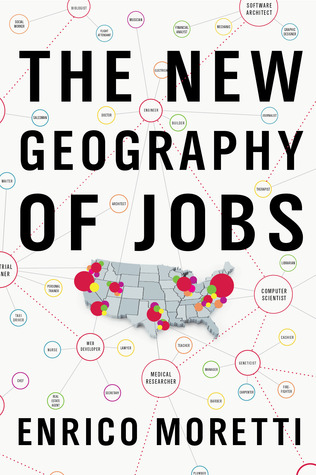TL;DR:
- Different jobs have different tradability. For example, yoga trainers or cab drivers deal with local customers (non-tradable), and jobs dealing with cars or software have the whole world as a market (tradable). The latter affects the price of the first.
- Market thickness is as important as the supply and demand of a market. The thickness is more crucial for innovation sectors requiring diverse skills: it is much more attractive to have 10,000 jobs and workers than 10 jobs and workers each. Cities get prosperous when labor and money attract each other, and it is hard to reverse the trend.
- The prosperity ends when the city cannot sustain innovation. New technologies become commodities, and more cities can perform yesterday’s complicated mechanism. So, Apple in California must keep innovating that others cannot imitate right away.
- It implies that your residency can be more important than your skills for your career. Your residence determines if you can grow quickly by working (and competing) with outstanding workers and generating high values.

In the past, prosperous cities had clear patterns of geography: easy access to water, structures to protect the city, etc. However, as the importance of intangible assets rises, it becomes increasingly harder to predict cities' falls and rises. It may seem obvious why Silicon Valley, NYC, and Seattle grew prosperous, but if you review the history, you can see that luck played a critical role. For example, if Bill Gates hadn’t started his company near his hometown, today’s Seattle would be vastly different. It shows how prediction is unstable, and we can easily confuse causes and outcomes.
How should we deal with this challenge? The first lesson is that flexibility is highly valuable. Moving to where you are valued is not just short-term greed but can be a wise choice for the long term. Besides your family, no one’s willing to pay you more than necessary. So, a high salary implies not just high values of yourself but a network of high-value individuals. However, it is also worth noting that the advantages may fade away if this network cannot sustain competency through innovations. So, the second lesson is to keep investing in education. This book repeatedly shows how a college education affects the entire lifespan, and I think it is apparent that you can extrapolate this message to more training. I’m sure continuous education through your 30s to 60s would have compounding impacts.
City policies play essential roles as well. For example, prosperous cities show increasing gaps between haves and have-nots. Unless the city keeps supplying housing and improving transportation systems, it will quickly lose its charms with high housing costs, homelessness, and a long commute. Even the unstoppable Silicon Valley faces this problem, and nearly half of the residents hope to leave1. It still has a dominant position, but the gaps with other cities are shirinking2. Of course, other than housing and commuting policies, labor laws or financial restrictions may also play essential roles in the cities’ fates. Moreover, managing the new wealth of prosperous cities can be a huge challenge. Not all fields get an equal reward of prosperity, and the inflow of new workers can unevenly impact the price of existing labor. The positive trend can quickly turn opposite when the government plays no role, but bad interruptions can be even more harmful.
For the already rich, followers are quickly catching up, but sustaining innovations and high productivity is challenging. So naturally, people grow nostalgic for the past. I see this both in the U.S. and Korea, where many long for a period of the rapid growth of 70s or 90s. Their past competitive edges have become commonalities, but many expect that simply bringing manufacturing back can repeat the growth. Unfortunately, I think there’s no way to keep prosperity with old technologies. So, we only have options between gradually losing values with minimal improvements and seeking prosperity with uncertain innovations. The claim applies not only to cities but to all individuals, corporations, and countries. ∎
More books to recommend:
- How Asia Works – Joe Studwell
- The Innovator’s Dilemma – Clayton Christensen
- The Idea Factory – Jon Gertner
-
Nearly half of Bay Area residents say they want to leave (Mercury News, 2018-06-03) ↩︎
-
Silicon Valley is changing, and its lead over other tech hubs narrowing (Economist, 2018-09-01) ↩︎